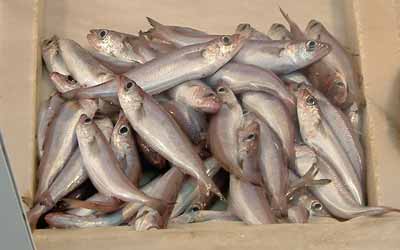Foxtail millet. It used to be eaten instead of rice by the poor. It hardens when it cools and is made into millet cakes and millet balls.
Tiny, brilliantly coloured sweetmeats fashioned from agar agar seaweed, sugar, egg whites and fruit.

Sweet smelt or freshwater trout. A lithe little fish which feeds on the algae at the bottom of rivers. This means that it will not take bait for the fishermen and so they train cormorants to catch them. The fishermen take them out in the darkness on moonless nights on their long shallow boats and shine lights to attract the fish. The birds' throats are bound so that they do not swallow the fish, which they bring back to the boats where they regurgitate them. This mode of fishing is called "ukai". They are served with a sauce of vinegar and nettles called tadesu. We attended a kaiseki ryori in Kyoto one May, the right season for these fish. One of the courses consisted of ayu. They were lightly fried and served whole, unlike many of the things which appeared in front of us that night which were predominantly raw, including sea cucumber. The late season ayu is known as ochiayu and is considered the best.
Adzuki bean. Small, red and shiny, slightly square beans with a white scar or hilum on the side. They are good in salads, mixed with other vegetables and also useful with other ingredients for stuffing because of their size. They are often used in sweet dishes as they have more natural sweetness than other beans. They are the basis of the red bean paste used in dim sum and of Japanese an, and are used a great deal in Chinese and Japanese cuisine, particularly for making sweet pastes. The flour is used in confections and puddings in China and Japan.